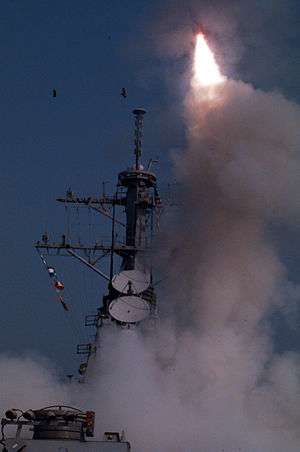1996 cruise missile strikes on Iraq
The 1996 cruise missile strikes on Iraq, codenamed Operation Desert Strike, were joint United States Navy-Air Force strikes conducted on 3 September against air defense targets in southern Iraq, in response to an Iraqi offensive in the Kurdish Civil War.
| Operation Desert Strike | |||||||
|---|---|---|---|---|---|---|---|
| Part of the Iraqi no-fly zones, the Iraqi Kurdish Civil War and the Persian Gulf Conflicts | |||||||
 USS Laboon launches Tomahawk cruise missiles at Iraqi air defense targets, 3 September 1996. | |||||||
| |||||||
| Belligerents | |||||||
|
|
| ||||||
| Commanders and leaders | |||||||
|
|
| ||||||
Iraqi offensive
On 31 August 1996, the Iraqi military launched its biggest offensive since 1991 against the city of Irbil in Iraqi Kurdistan to defuse the Kurdish Civil War between the Patriotic Union of Kurdistan and Kurdistan Democratic Party. This attack stoked American fears that the Iraqi leader Saddam Hussein intended to launch a genocidal campaign against the Kurds similar to the campaigns of 1988 and 1991. It also placed Saddam in clear violation of United Nations Security Council Resolution 688 forbidding repression of Iraq's ethnic minorities.
Cruise missile strikes
The strikes were initially planned to be by aircraft launched from the aircraft carrier USS Carl Vinson, including aircraft from Fighter Squadron 11 (VF-11) and Fighter Squadron 31 (VF-31), both operating F-14D Tomcats; Electronic Attack Squadron 139 (VAQ-139), operating EA-6B Prowlers; Attack Squadron 196 (VA-196), operating A-6E Intruders equipped with the Target Recognition and Attack Multi-Sensor (TRAM) system; Anti-Submarine Squadron 35 (VS-35) flying S-3B Vikings; and Strike Fighter Squadron 113 (VFA-113) and Strike Fighter Squadron 25 (VFA-25), both operating F/A-18 Hornets. However the strike was instead launched by U.S. Navy surface warships and U.S. Air Force bombers, using cruise missiles.

On 3 September 1996, a joint operation by the U.S. Navy's Carl Vinson Carrier Battle Group and U.S. Air Force, a combined strike team consisting of the guided-missile cruiser USS Shiloh, the guided-missile destroyer USS Laboon, and B-52 Stratofortress bombers escorted by F-14D Tomcat fighters from Carl Vinson, with the nuclear-powered guided-missile cruiser USS California serving as Air Warfare Commander[1], launched 27 cruise missiles against Iraqi air defense targets in southern Iraq.[2] A second wave of 17 missiles was launched later that day[3] from the destroyers USS Russell, USS Hewitt, USS Laboon, and the nuclear-powered attack submarine USS Jefferson City. The missiles hit targets in and around Kut, Iskandariyah, Nasiriyah, and Tallil.[4]
Aftermath
The attacks were primarily aimed at retaliation for the targeting of USAF fighters in the Northern and Southern no-fly zones, and were targeted at surface-to-air missile sites and command, control, and communication locations, with the intention of degrading the Iraqi air defense infrastructure. These strikes, along with follow-on deployments of troops, aircraft, and the addition of a second aircraft carrier to the region, achieved their desired results.
It is debatable whether the attacks did or did not have a substantial effect on Iraq's northern campaign. Once they installed the Kurdistan Democratic Party (KDP) in control of Irbil, Iraqi troops withdrew from the Kurdish region back to their initial positions. The KDP drove the Patriotic Union of Kurdistan (PUK) from its other strongholds, and with additional Iraqi help, captured Sulaymaniyah. The PUK and its leader, Jalal Talabani, retreated to the border, and American forces evacuated 700 Iraqi National Congress personnel and 6,000 pro-Western Kurds out of northern Iraq.[5]
In response to Iraq's moves, the United States and United Kingdom also expanded Operation Southern Watch and the southern Iraqi no-fly zones from the 32nd parallel to the 33rd parallel, bringing it to the edges of Baghdad itself.[2]
References
- https://www.history.navy.mil/content/history/nhhc/research/histories/ship-histories/danfs/c/carl-vinson--cvn-70-.html
- Pike, John. "Operation Desert Strike". GlobalSecurity.org.
- Macko, Steve (3 September 1996). "US Launches 2nd Cruise Missile Attack in Iraq". Emergencynet News Service. Archived from the original on 9 February 2005.
- "U.S. launches missile strikes against Iraq". CNN. 3 September 1996.
- Plotz, David (28 September 1996). "The Kurds". Slate.

